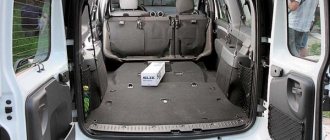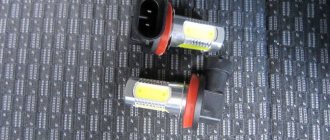Trunk size Lada Largus station wagon 5 and 7 seats, van, Cross
Whatever the size of the Lada Largus trunk, it will never be enough. Of course, if you are buying a car solely for transporting yourself and infrequent trips to the country, then you are unlikely to say that the luggage compartment in Largus is small. However, those who take this station wagon for work will never say that the trunk of the Lada Largus is large and there is a lot of space in it. After all, there is never too much working volume.
As you already know, LADA Largus is available in three modifications:
— Passenger station wagon R90. — A station wagon with increased capacity (the so-called 7-seater station wagon). — F90 cargo van.
All these modifications are tailored to suit your needs and have different luggage compartment volumes. Let's start with the R90 passenger station wagon.
Are there any competitors?
Due to its body layout, the Lada Largus does not have a large number of its “opponents,” especially in the market spaces of the CIS countries. This can be partly explained by moderate demand. If we again tend to limit ourselves only to post-Soviet market areas, then we are unlikely to find a worthy competitor to this station wagon in terms of carrying capacity. Impressive figures can serve as a simple confirmation of this:
- the van is able to overcome a weight of 800 kg;
- the station wagon can handle a 650-kilogram load, the volume in liters allows this.
Competitors are only able to get closer to these indicators, because their load capacity is at the level of 450-600 kg. The list of dimensional characteristics of the Largus trunk may bring a little disappointment, because in this discipline the station wagon is not a leader, but it is not “tagging along” in the “tail of the tournament bracket”.
Detailed information regarding dimensions is most clearly reflected in the following table:
As you can see, two positive aspects speak in favor of the universal “Russian woman”:
- enviable convenience when loading luggage, especially large ones, which is facilitated by the door opening limit (reaches 180 degrees with the doors fully turned out); Not a single universal model can boast of this feature;
- reasonable cost of the car, which is especially noticeable in comparison with famous competitors.
Important! Against the background of the entire set of indicators characterizing the versatility of the LADA Largus, it can be unequivocally stated that the domestic model, although in some minor disciplines loses to its rivals, in general terms, against their background it looks very decent and advantageous. Here, few will argue with the functionality of the “Russian woman”.
Trunk capacity Lada Largus 7 seats
The trunk volume of the Lada Largus 7 seats is very, very modest - only 135 liters. This is due to the fact that the car has been adapted for greater passenger capacity. However, if you fold the third row of seats, you can easily increase the luggage compartment volume of a seven-seater station wagon to approximately 500-560 liters. The figure is not entirely accurate, since we take into account the trunk volume of the five-seater version of the station wagon, which is 560 liters. But useful space will still be occupied by folded seats. 560 liters will be if the third row of seats is removed and removed from the car.
If you fold down the second row of seats, then the trunk volume of the Lada Largus for 7 seats will be a decent 2350 liters.
Cross
The smallest trunk size is in the Largus minivan, designed for 7 seats. The Largus Cross trunk reaches a volume of 200 liters. The manufacturer helped car owners by allowing them to increase the volume of the luggage compartment in liters to 1600–1800, for which two rows of seats should be removed.
The seven-seater version (minivan) has the most “modest” luggage compartment. But the manufacturer met his loyal customer halfway and endowed this modification with a simple secret: it is also possible to increase the luggage space to the same 1600–1800 liters by performing an identical operation to dismantle the stern seats. To do this, you will need to remove two planting rows.
Luggage compartment volume Lada Largus Van
The Lada Largus Van has the most impressive figures - its trunk volume is 2540 liters. This car is in great demand among commercial organizations, so special attention was paid to the trunk volume when designing this car.
There is another version of the Lada Largus station wagon - a CNG gas fuel version with a trunk volume of 2225 liters. This is slightly smaller than a regular van due to the gas cylinder placed inside.
Options and prices
Lada Largus 5 seats
The five-seater station wagon with a base 84-horsepower engine is offered in two trim levels – “Standard” and “Norma”. The Lada Largus “Standard” package includes: driver airbag, immobilizer, one-piece second-row seat, tilt-adjustable steering column, full-size spare wheel and 15-inch steel wheels. The cost of LADA Largus (5 seats) in this version is 444,000 rubles.
A station wagon with the same engine in the “Norma” configuration additionally received: anti-lock brakes, a split second-row seat, a mirror in the passenger sun visor, central locking, front power windows, power steering, door moldings and bumpers in body color. The price of Lada Largus 5 seats in this version is 468,000 rubles. A package of options is also available (heated front seats and air conditioning), costing 22,000 rubles.
But a modification of the five-seater Largus with a 105 hp engine is offered by the manufacturer only in the “Lux” configuration. This version has the following “stuffing”:
- driver and front passenger airbags;
- ABS;
- immobilizer;
- anti-fog optics;
- on-board computer;
- second-row split seat;
- curtain shelf in the cargo compartment;
- power steering;
- 4 electric windows;
- heated front seats;
- tilt steering wheel adjustment;
- heated and electrically adjustable exterior mirrors;
- audio system with MP3, USB, Bluetooth and 4 speakers;
- central locking with remote control;
- air conditioner;
- rear-view mirrors, door handles and bumpers in body color;
- roof rails
The cost of such a car is already 536.7 thousand rubles. An optional package is also offered (leather steering wheel and 15-inch alloy wheels) costing 6,500 rubles.
Lada Largus 7 seats
The seven-seater Largus with an 84-horsepower engine received the only “Norma” package. It includes the following elements: immobilizer, driver's airbag, ABS, third row of seats, second-row split seat, audio preparation, front electric windows, heated front seats, central locking, power steering, air conditioning, body-colored bumpers and a full-size spare wheel. The price of this station wagon is 509 thousand rubles. Options include a front passenger airbag and an audio system with USB, MP3 and Bluetooth + 2 speakers. The cost of the option package is 9,500 rubles.
Its more powerful brother, which has a 105-horsepower engine under its hood, is sold in the “Lux” version. The buyer has access to: driver and front passenger airbags, anti-lock brakes, fog lights, immobilizer, on-board computer, split seat in the second row and split backrest in the 3rd row, third row of seats, hydraulic power steering, front and rear power windows, heated driver's seats and front passenger, electrically adjustable and heated exterior rearview mirrors, audio system with 4 speakers, central locking with remote control, air conditioning, door handles, bumpers and mirrors in body color, roof rails and 15-inch stamped wheels. The price of Lada Largus (7 seats) in the “Lux” configuration is 555,700 rubles. An options package is also available, which includes 15-inch alloy wheels and a leather-wrapped steering wheel. For options you will have to pay an additional 6,500 rubles.
Trunk dimensions of Lada Largus station wagon and Cross
To estimate the actual dimensions of the trunk of the Lada Largus station wagon, we will take measurements using a regular tape measure and transfer everything to the diagram. We will use a regular photograph and a graphic editor as a diagram. In this case, we will not get 100% accurate measurements, but they will be as close to reality as possible. Here is a photo of the trunk of a Lada Largus station wagon with specific dimensions:
- The height from the floor to the bottom point of the ceiling is 905 mm.
- The length of the trunk from the lock to the rear row of seats is 1199 mm.
- The height of the trunk to the shelf is 477 mm.
- The length of the trunk with the second row of seats folded is 1700 mm.
- Trunk width 1000 mm.
The Cross version has the same luggage compartment volume.
Skoda Roomster
The Skoda Roomster has excellent handling, a low seating position, and a spacious trunk. The minimum trunk capacity is 450 liters, and with the rear seats folded down this figure increases to 1780 liters. The cost of the car starts from 614,000 rubles; this configuration includes a 1.4-liter engine with 84 hp, a five-speed manual transmission, front airbags, air conditioning and a stabilization system.
Skoda Roomster - does not compete in terms of volume and price
By paying an additional 40 thousand rubles, you can purchase a car with a 1.6 liter engine with 105 hp. Also, if necessary, you can order this car with an automatic transmission; it will be 70,000 rubles more expensive than the basic configuration.
Dimensions of the trunk of the Lada Largus cargo van in cm
We will do the same with the van version. We find the corresponding photo and look:
- The height from the floor to the bottom point of the ceiling is 92 cm.
- The length of the trunk from the lock to the partition is 194 cm.
- The trunk width is 96 cm.
- The width of the doorway is 108 cm.
- Trunk diagonal – 128 cm.
dimensions of the cargo compartment, trunk volume
On a regular Lada Largus van, the body dimensions are selected so that Euro pallets can be transported. We are talking not only about the space between the pillars, which are spaced 108 cm apart, but also about the distance between the wheel arches. It is 96 cm, and one pallet takes 80. The distance from the rear doors to the partition generally approaches two meters! A little more and it would have been possible to fit a couple of Euro pallets. Here we will look at how to remove the partition between the body and the cabin, and at the same time remove the inner bottom of the body. The first is needed for transporting long cargo, the second is also used for some reason.
We study the fastening of partitions and floors. Everything is shown in one video.
Linear dimensions of the cargo compartment of the Lada Largus van
All the sizes you need to know are shown in the photo. The van doors here are fixed at an angle of 90 degrees, but they can be opened all the way to 180. They are fixed in either of the two positions.
Luggage compartment of a Largus van
Let's list everything that is marked in the figure:
- The greatest height of the opening is 92 cm;
- Opening width – 108 cm;
- The distance “from arch to arch” is 96 cm;
- The distance from the edge of the threshold to the partition is 194 cm.
If you lay sheets diagonally, the width of the sheet should be less than 130 cm.
When the partition remains in place, the internal volume of the Lada Largus van is 2540 liters. Load capacity is 725 kg. These figures are indicated by AvtoVAZ.
In fact, the maximum lifting capacity exceeds a ton. It all depends on the road conditions and driving style.
Unfasten the partition or part of it
The partition separating the body and the cabin consists of two halves. They can be removed separately. Both parts are screwed to the body with screws designed for a 13mm key size. Of course, you need a socket wrench.
Screws 1 were hidden under the casing
The four screws on the left and right are located on the cab side. And to unscrew them, remove the casing.
All actions with cladding
The left part of the septum is removed after the right. To remove only the left half, first remove both, and then mount the right sash back. Based on this, immediately decide where you will remove the trim - only on the right or on both sides.
The volume of the body on the Lada Largus van cannot be greatly increased, even if the partition is completely removed. But without the partition, by removing the seat, it will be possible to transport loads 3 meters long.
So, let's start dismantling the trim: you need to remove the seat belt (key “17”), and then unscrew one self-tapping screw. A Torx T20 wrench is suitable for the self-tapping screw.
Two parts “1” prevent the removal of casing “2”
It is necessary to unscrew all the parts numbered 1. And the casing will have to be removed, overcoming the resistance of the clamps.
Removing the partition
First, unscrew the four screws shown at the beginning of the chapter (key “13”). Then with the same key they go into the body.
All fasteners are the same
As you can see, both halves are held on three sides: top, bottom, middle. The number of screws will be as follows: four at the top and bottom, five at the seam between the sashes. Work order:
- Completely unscrew the four screws on top;
- While holding the nuts on the seam, unscrew the screws from the cabin side;
- The lower screws are unscrewed 2-3 turns. Then all parts are disengaged.
Let us remind you that the right wing can be removed separately. We wish you success.
Increasing the volume of the cargo compartment (removing the excess part on the floor)
The cargo compartment volume of the Lada Largus van can be increased. To do this, remove the floor covering.
There are two types of fasteners here
We will need special Torx keys, without which the screws cannot be unscrewed: Torx T30 and T40.
Study the picture carefully:
- T40 caps (2) are located at the corners, as well as on the line between the arches;
- The remaining screws (1) are designed for Torx T30 keys.
Removing the trim will be easy. And when you install it, make rubber gaskets. They are fixed to the ends of the frame so that the casing does not rust.
The removable floor (cladding) consists of two halves - left and right. First, according to tradition, the right one is removed.
Articles
- Floor fixing screw T30 – 7703008207;
- Floor fixing screw T40 – 7703008162;
- Floor panels, left and right – 6001548794 and 6001548795 respectively;
- Partition fastening screw (removable) – 7705096068;
- Partition mounting screw (non-removable) – 6001549488;
- Nut M6x100 (seam) – 6001549489;
- Left and right partition – 6001549485 and 6001549486 respectively.
Trunk Lada Largus photo
dimensions of the cargo compartment, trunk volume
On a regular Lada Largus van, the body dimensions are selected so that Euro pallets can be transported. We are talking not only about the space between the pillars, which are spaced 108 cm apart, but also about the distance between the wheel arches. It is 96 cm, and one pallet takes 80. The distance from the rear doors to the partition generally approaches two meters! A little more and it would have been possible to fit a couple of Euro pallets. Here we will look at how to remove the partition between the body and the cabin, and at the same time remove the inner bottom of the body. The first is needed for transporting long cargo, the second is also used for some reason.
We study the fastening of partitions and floors. Everything is shown in one video.
Linear dimensions of the cargo compartment of the Lada Largus van
All the sizes you need to know are shown in the photo. The van doors here are fixed at an angle of 90 degrees, but they can be opened all the way to 180. They are fixed in either of the two positions.
Luggage compartment of a Largus van
Let's list everything that is marked in the figure:
- The greatest height of the opening is 92 cm;
- Opening width – 108 cm;
- The distance “from arch to arch” is 96 cm;
- The distance from the edge of the threshold to the partition is 194 cm.
If you lay sheets diagonally, the width of the sheet should be less than 130 cm.
When the partition remains in place, the internal volume of the Lada Largus van is 2540 liters. Load capacity is 725 kg. These figures are indicated by AvtoVAZ.
In fact, the maximum lifting capacity exceeds a ton. It all depends on the road conditions and driving style.
Unfasten the partition or part of it
The partition separating the body and the cabin consists of two halves. They can be removed separately. Both parts are screwed to the body with screws designed for a 13mm key size. Of course, you need a socket wrench.
Screws 1 were hidden under the casing
The four screws on the left and right are located on the cab side. And to unscrew them, remove the casing.
All actions with cladding
The left part of the septum is removed after the right. To remove only the left half, first remove both, and then mount the right sash back. Based on this, immediately decide where you will remove the trim - only on the right or on both sides.
The volume of the body on the Lada Largus van cannot be greatly increased, even if the partition is completely removed. But without the partition, by removing the seat, it will be possible to transport loads 3 meters long.
So, let's start dismantling the trim: you need to remove the seat belt (key “17”), and then unscrew one self-tapping screw. A Torx T20 wrench is suitable for the self-tapping screw.
Two parts “1” prevent the removal of casing “2”
It is necessary to unscrew all the parts numbered 1. And the casing will have to be removed, overcoming the resistance of the clamps.
Removing the partition
First, unscrew the four screws shown at the beginning of the chapter (key “13”). Then with the same key they go into the body.
All fasteners are the same
As you can see, both halves are held on three sides: top, bottom, middle. The number of screws will be as follows: four at the top and bottom, five at the seam between the sashes. Work order:
- Completely unscrew the four screws on top;
- While holding the nuts on the seam, unscrew the screws from the cabin side;
- The lower screws are unscrewed 2-3 turns. Then all parts are disengaged.
Let us remind you that the right wing can be removed separately. We wish you success.
Increasing the volume of the cargo compartment (removing the excess part on the floor)
The cargo compartment volume of the Lada Largus van can be increased. To do this, remove the floor covering.
There are two types of fasteners here
We will need special Torx keys, without which the screws cannot be unscrewed: Torx T30 and T40.
Study the picture carefully:
- T40 caps (2) are located at the corners, as well as on the line between the arches;
- The remaining screws (1) are designed for Torx T30 keys.
Removing the trim will be easy. And when you install it, make rubber gaskets. They are fixed to the ends of the frame so that the casing does not rust.
The removable floor (cladding) consists of two halves - left and right. First, according to tradition, the right one is removed.
Articles
- Floor fixing screw T30 – 7703008207;
- Floor fixing screw T40 – 7703008162;
- Floor panels, left and right – 6001548794 and 6001548795 respectively;
- Partition fastening screw (removable) – 7705096068;
- Partition mounting screw (non-removable) – 6001549488;
- Nut M6x100 (seam) – 6001549489;
- Left and right partition – 6001549485 and 6001549486 respectively.
What is included in the trunk of a Lada Largus van?
The trunk of a station wagon and a Lada Largus van have approximately the same figures. The difference is that the back row of seats was removed from the van and an all-metal partition was installed. The van's pillar cups were also strengthened to allow the vehicle to carry heavier loads.
Thus, the trunk was designed so that a Euro pallet measuring 80x120 cm could easily fit into it.
What you can see in the following photo:
Lada Largus technical specifications
Many potential car buyers are interested in the main technical characteristics of the Lada Largus. The car is a clone of the Dacia Logan MCV car of the Renault-Nissan alliance, which has gained some popularity in Europe, redesigned for domestic operating conditions. The Lada Largus model has similar technical characteristics. The car body type belongs to the category of high-capacity station wagons, and the dimensions of the Lada Largus allow the car to be classified both as spacious family cars and ultra-compact commercial vans.
Return to contents
Main body dimensions
The dimensions of the Lada Largus car differ little from those of its competitors, such as Fiat Doblo, Renault Kangoo, Peugeot Partner, Citroen Berlingo, Skoda Roomster, Volkswagen Caddy, Ford Connect Transit. The overall dimensions (body length/width/height) of the Peugeot Partner are 4380/1810/1800 mm, and the body dimensions of the Lada Largus are approximately the same.
Main dimensions of Lada Largus:
- length - 4470 mm;
- width - 1750 mm;
- height (including the dimensions of the roof rails) - 1670 mm;
- car base - 2900 mm;
- front track - 1469 mm;
- rear track - 1466 mm;
- front overhang - 795 mm;
- rear overhang - 770 mm;
- ground clearance under the lowest point of the engine - 145 mm;
- turning radius - 5.62 m.
The Lada Largus body has a hinged rear door. This ensures easy access to the luggage compartment, even in limited parking spaces. The left rear door leaf is noticeably wider than the right one, and the design of the car allows only it to be opened when loading and unloading.
Consumers care whether the Largus body is galvanized. It is known that all steel panels of the machine are double-sided galvanized.
Return to contents
Station wagon engine
The car comes with an 8-valve or 16-valve 4-cylinder fuel-injected engine with multiport fuel injection. The volume of these engines is 1598 cm3; cylinder diameter - 79.5 mm; piston stroke - 80.5 mm; compression ratio - 9.8. The 8-valve engine produces 90 horsepower and a torque of 128 N∙m. The maximum speed of Largus, equipped with such an engine, is 158 km/h, and acceleration to 100 km occurs in 13.4 s. The 16-valve engine is slightly more powerful, it produces 105 horsepower and a maximum torque of 148 N∙m. In this version, the maximum speed is 165 km/h, acceleration to 100 km is 11.8 s.
Lada Largus engines consume gasoline with an octane rating of 95. The car complies with Euro 4 standards. Lada Largus fuel consumption per 100 km in the combined cycle for a 5-seater version and a 16-valve engine is 11.5 liters, and on the highway - 7.6 liters per 100 km.
The Largus' curb weight is 1269 kg, and if you add the weight of luggage and the driver, the total weight will be 1784 kg. The total weight of Largus without a driver is 1701 kg. The distribution of the total weight is as follows: on the front axle - 833 kg, on the rear - 868. With such weight indicators, fuel consumption is quite expected.
Diesel is popular both in the commercial vehicle segment and in the large family car category. But VAZ does not offer a diesel engine. The lack of an option with an automatic transmission also seems somewhat anachronistic in our time; only a 5-speed manual gearbox is offered.
Return to contents
Chassis of Lada Largus
The car is front-wheel drive, like most VAZ models. Wheel formula - 4x2. There is no all-wheel drive version. The wheels have a radius of 15 inches. Tires of a very common size are used - 185/65R15.
The brakes on the front wheels are disc, there is automatic adjustment of the gap between the disc and the brake pads. The rear brake is drum with automatic adjustment of the gap between the drum and the brake pads. The parking brake of the machine is equipped with a manual cable drive on the brake mechanism of the rear wheels. As an option, it is possible to install an anti-lock braking system (ABS) with electronic distribution of braking forces along the axles.
The suspension and braking system of Largus allow the vehicle to be used with a trailer. The weight of a trailer not equipped with a braking system, if the vehicle does not have an ABS system, is 420 kg, and with ABS - 620 kg. For a car with only one driver in the cabin, the permitted weight of the trailer, if it has brakes, reaches 1300 kg.
Return to contents
Vehicle options
Lada Largus comes in 4 main versions:
- basic: 5-seater station wagon with increased capacity;
- 7-seater station wagon;
- 2-seater all-metal van;
- Lada Largus Cross.
The main configuration option is a 5-seater station wagon with increased capacity. The lack of sliding doors in the second row is partly compensated by the presence of a hinged rear door, which provides ease of loading/unloading. The trunk volume of the car as standard is 560 liters.
The second row seats can be easily removed. To do this, you need to unscrew only 2 bolts and move the chairs back until they disengage with the mounting brackets. With this dismantling, the car becomes a two-seater, and the trunk volume increases to 2540 liters.
The 7-seater version differs from the basic one by the presence of a third row of 2 seats. The trunk capacity is only 135 liters. Not too much for seven. The third row of seats can be removed just as easily as the second. And if there is somewhere to store the dismantled seats, this option for transforming the interior may well look attractive.
Largus' version for the ultra-compact commercial vehicle segment is a 2-seater all-metal van. The rear doors look somewhat unexpected; they do not move, like in a passenger station wagon, but they do not have glass. The van's trunk capacity is 2540 liters. The line of models does not include an extended version, which is presented by competitors.
Another modification of the high-capacity station wagon is the Lada Largus Cross. The prefix “cross” makes you think about cross-country ability, but the parameters of this model do not allow it to be classified as a full-fledged SUV. Even the ground clearance increased to 170 mm and 16-inch wheels in the absence of all-wheel drive allow us to consider the Largus Cross, at best, a car in the SUV category.
expertvaz.ru
Let's sum it up
The owners today have gained considerable experience in using LADA Largus in various fields and industries. They all nod their heads contentedly when asked about the convenience and practicality of the trunk. On the Internet you will find only a limitless mass of positive reviews about this model.
The size of the trunk turned out to be sufficient for the car to effectively demonstrate its functionality and be able to take the lead from competitors “touching on their heels.” The manufacturer managed to competently and rationally arrange the body space, which allows the station wagon to effectively cope with large objects, demonstrating an enviable carrying capacity. We definitely note that we recommend purchasing this station wagon for those who have not yet found a real “hard worker” as a companion, possessing a full range of balanced consumer and technical properties.
Video review of the LADA Largus luggage compartment:











